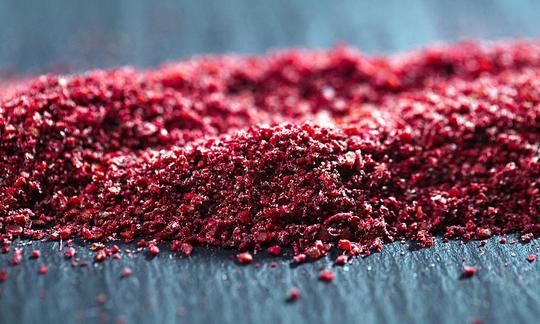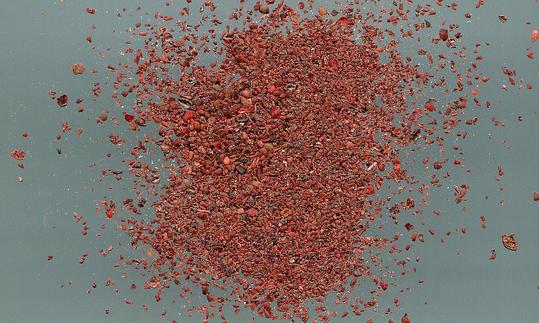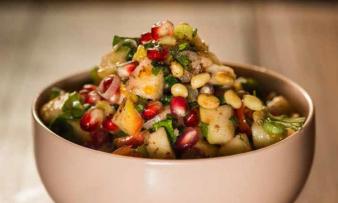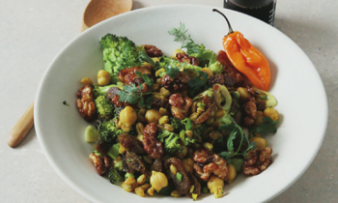Table of contents
Tanner’s Sumac ( Rhus coriaria), also called sumac or sumac, is a fruity-sour spice ( raw?) and goes wonderfully with oriental dishes. Organic quality is available.
Using sumac in the kitchen:
What is sumac? What is sumac? Sumac (Turkish: Sumak or Somak 4) is a spice from oriental cuisine that is used as a table spice, especially in Turkey. What kind of spice is sumac? The spice is obtained from the dark red stone fruit of the evergreen dye tree. Spice sumac has a pleasant, fresh, sour and slightly fruity taste. It can therefore be used as a fruity alternative to (or as a complement to) lemon juice and vinegar.
Sumac spice is used for all kinds of vegetarian and vegan dishes as well as for raw vegetable salads. Sumac gives hearty bean stews, rice stews and braised dishes a fresh note. The spice also tastes excellent with potato salad or grilled vegetables. Onion salads, bulgur salads (kisir), vegan cig kofte (vegan meatballs made from bulgur) and stuffed vine leaves are popular dishes from Turkish cuisine that are prepared with sumac. Sumac spice is also great for refining oriental dips such as baba ghanoush and hummus.
Sumac is often used in spice mixtures. The Arabic spice mixture Za'atar (Zatar, Satar) is a dry mixture of sesame, salt and herbs (eg thyme, oregano, marjoram), which also contains sumac. Winter onions, garlic, coriander, mint, parsley and spices such as paprika, allspice and chili also go well with sumac.
Vegan recipe for Turkish onion salad with sumac:
Ingredients (for 2 people): 6 onions (small), 3 tomatoes, 2 tbsp rapeseed oil, 1 bunch of parsley (raw), 1 tsp sumac spice (organic), ½ tsp ground cumin, ½ tsp lemon juice, some chili powder and salt.
Preparation: Peel raw onions, halve and cut into wedges. Rinse briefly with cold water and drain. Rinse parsley, shake dry and chop finely. Mix onions in a bowl with fresh parsley, sumac, cumin powder, lemon juice, chili powder and salt. Add rapeseed oil when the desired taste is achieved. Wash tomatoes and cut into half slices. Arrange tomato slices on a plate and place the vegan onion salad on top or mix tomatoes with the onions.
Vegan recipes with tanner sumac can be found under the note: " Recipes that have the most of this ingredient ".
| Not only vegans or vegetarians should read this: Vegans often eat unhealthily. Avoidable nutritional errors. |
Shopping - where to buy sumac?
Pure sumac is rarely found in supermarkets such as Coop, Migros, Denner, Volg, Spar, Aldi, Lidl, Hofer etc. or in organic supermarkets (e.g. Alnatura, Denn's Biomarkt). Well-stocked shops such as Rewe and Edeka sell pure sumac spice. Other shops, such as Coop, offer spice mixtures with sumac. You will often have more luck in Turkish shops, online shops and delicatessens.
The spice sumac is also available in organic quality (organic). If you want high-quality sumac spice, you should go for pure powder in airtight containers. Sumac is often sold mixed with salt, which causes the spice to lose its taste more quickly. Raw quality (raw food quality) cannot be taken for granted, as very high temperatures can also be reached during sun drying.
Wild:
Tanner's Sumac is found in the wild in Algeria, Southern Europe, Ukraine, the Canary Islands, the Caucasus region, Central Asia and Western Asia. 1
Storage of sumac:
Like other spices, sumac should be stored in an airtight container in a dry, dark place so that the taste and aroma are not lost. The shelf life is between two and three years.
Sumac ingredients - nutritional values - calories:
Here we realistically show you the ingredients of spices and herbs per 1 g (instead of per 100 g as usual).
The energy content of sumac is 3.4 kcal/1g, of which 0.65 g are carbohydrates. It is a spice rich in fiber and, with 0.17 g/1g, also high in fat - comparable to cayenne pepper (0.17 g/1g) and the spice mixture garam masala (0.16 g/1g). 2
Sumac fruits are rich in potassium, calcium, magnesium, followed by iron and zinc, among others. Sumac spice can be a good supplement to increase the dietary intake of minerals such as potassium and calcium. 3
The sour taste of tannin sumac comes from the fruit acids it contains (including malic acid, citric acid, tartaric acid, etc.).
Studies on the spice's vitamin composition are still lacking. A comparative study conducted in China on the difference between Syrian and Chinese sumac listed some of the vitamins present in Rhus coriaria : thiamine (vitamin B1), riboflavin (vitamin B2), pyridoxine (vitamin B6), vitamin B12 (cobalamin), biotin and ascorbic acid (vitamin C). Of these vitamins, pyridoxine was the most abundant, followed by ascorbic acid, thiamine and riboflavin. 3
The complete ingredients and nutritional values of sumac, the coverage of the daily requirement and comparison values with other ingredients can be found in our nutrient tables. In the article Nutrients explained you will get a detailed insight into the topic.
Health aspects - Effects:
Sumac stimulates the digestion of fatty foods. Extracts obtained from various parts of the plant also have a broad spectrum of bioactivities. The secondary plant substances they contain have antioxidant, antimicrobial, antidiabetic, anti-inflammatory and cytotoxic effects (in the sense of various antitumor activities). 5 Rhus coriaria is one of the plants with proven effects against various types of cancer, 6 and a complementary therapeutic application is said to be particularly promising in breast cancer. 5,9
Regular consumption of sumac powder can help diabetics reduce their susceptibility to cardiovascular disease. 10
Studies have shown that Rhus coriaria has potential neuroprotective activities and could help with retinal degeneration. Sumac is said to be useful in preventing and treating dental diseases. 6
Dangers - Intolerances - Side effects:
Anyone who is allergic to members of the sumac family, such as cashew nuts, mangos or pistachios, should be careful when consuming sumac spice.
Is sumac poisonous? The tanner's sumac is not poisonous. However, it has poisonous relatives, such as the poison sumac (see under risk of confusion).
A review published in 2020 attests to the (raw) spice's safe application potential. Based on numerous study results, the authors conclude that its antibacterial, antifungal and antioxidant properties make it a versatile tool for the food industry, where it can be used as an effective preservative and natural, safe food additive. 3
Folk medicine - naturopathy:
In traditional Mediterranean medicine, various ailments were treated with sumac, including diarrhea, hemorrhoids, liver diseases, eye diseases, internal bleeding, respiratory problems and ulcers. 5
Occurrence - origin - ecology:
The plant Rhus coriaria is found in temperate and tropical regions worldwide. The largest areas where sumac is grown are in the Mediterranean and the Middle East. 11 Its importance as a popular spice and medicinal plant goes back a long way. 12 In the 3rd century BC it was used extensively in Greek cuisine in the Aegean region.
Cultivation - Harvest:
The fruits of the tanner sumac grow on the evergreen dye tree. When ripe, they turn dark red to violet-red. The ripe fruits are harvested in early autumn. The pulp is then dried and ground into a powder. The powder is dark because the fruits are ground with the seeds. Traders sometimes add salt to the tanner sumac to speed up the drying process and increase the weight of the spice.
When making the bright red sumac spice of the highest quality, the stone fruits are not ground up, as this would cause bitter substances to escape. Only the thin layer of pulp is scraped off and then dried under strong sunlight: This is why the spice cannot be considered a raw food. This quality of sumac is more expensive and rarely available in stores.
Ecological aspects:
Sumac is grown conventionally, but also organically. We recommend buying organic sumac. Organic quality is not so easy to find, but the effort is worth it, as no chemicals or pesticides that are harmful to nature are used in the cultivation process. Many organic products also carry the Fairtrade label.
The water consumption of the sumac plant is considered low.
Risk of confusion:
The fruits of the tanner's sumac ( Rhus coriaria) are most likely to be confused with those of the sumac tree ( Rhus typhina, syn. Rhus hirta (L.) Sudw.), also known as staghorn sumac or cob sumac 13. The latter's toxicity is limited, and results in stomach and intestinal problems after eating large quantities of raw fruit. In Switzerland, the plant is on the black list of invasive neophytes and is therefore a prohibited alien plant (according to the release ordinance FrSV, SR 814.911). 14 Indigenous peoples of North America process the sumac tree fruits (sumac tree spice) into a refreshing and sour drink called 'Indian lemonade'.
The leaves of the fragrant sumac ( Rhus aromatica) resemble those of the poison sumac ( Rhus toxicodendron), whose urushiols are very poisonous. 7
The common name spice sumac can be found for both Rhus coriaria and Rhus aromatica; the first (tanner sumac) is mainly used as a spice.
General information:
Tanner's sumac ( Rhus coriaria) is a plant species in the genus Sumach in the family Anacardiaceae. The name Sumach is of Semitic origin and is derived from the root word for "red". 3,4,8 Tanner's sumac was once used to treat (tan) leather - hence the name (see below).
Alternative names:
Tanner's sumac is also known by the following names: sumac, sumac (somak, sumac), sumaq, Sicilian sugar, Sicilian sumac, spice sumac or dye tree (sometimes also non-specifically, sumac tree).
Is Sumak German? Sumak with -k is actually the Turkish spelling. Sumak in German is: Sumach. Incorrect spellings like Sumark, Sumagewürz, Somak Gewürz, Gerber Sumach, Sumagewürz, Sumak Gewürz, Sumack Gewürz, Sumah, Rhus coraria etc. creep in.
In English, tanner's sumac is known as sumac, shumac, tanner's sumac, tanner's sumach, Sicilian sumac or elm-leaved sumach. In Arabic, the equivalent is سماق (summaaq or summaq). 4
Keywords for use:
Sumac has antifungal and antibacterial effects, which is why an aqueous or ethanolic sumac extract could be considered as a disinfectant, but also as a natural preservative in the food industry. 6
The leaves and bark of the sumac bush, which contain large amounts of tannins, have been used for centuries to tan leather 6 to make it soft, supple and durable. In cosmetics, the fruits of the sumac are used for hair care, eg against dandruff, for coloring and cleaning the hair. 8
Literature - Sources:
Bibliography - 13 Sources (Link to the evidence)
| 1. | GRIN-Global. U.S. National Plant Germplasm System: Rhus coriaria L. |
| 2. | USDA United States Department of Agriculture. |
| 3. | Sakhr K, El Khatib S. Physiochemical properties and medicinal, nutritional and industrial applications of Lebanese Sumac (Syrian sumac - rhus coriaria): A review. Heliyon. 2020;6(1): e03207. |
| 4. | Gernot-katzers-spice-pages.com Gernot Katzers Gewürzseiten. Sumach (Rhus coriaria L.). |
| 5. | Elagbar ZA, Shakya AK, Barhoumi LM, Al-Jaber HI. Phytochemical diversity and pharmacological properties of Rhus coriaria. Chem Biodivers. 2020;17(4): e1900561. |
| 6. | Alsamri H, Athamneh K, Pintus G et al. Pharmacological and Antioxidant Activities of Rhus coriaria L. (Sumac). Antioxidants. 2021;10(1): 73. |
| 7. | Pahlow M. Das grosse Buch der Heilpflanzen. Gesund durch die Heilkräfte der Natur. Nikol Verlagsges. mbH: Litauen; 2013: 444-445. |
| 8. | Farag MA, Fayek NM, Abou Reidah I. Volatile profiling in Rhus coriaria fruit (Sumac) from three different geographical origins and upon roasting as analyzed via solid-phase microextraction. PeerJ. 2018;6: e5121. |
| 9. | El Hasasna H, Athamneh K et al. Rhus coriaria induces senescence and autophagic cell death in breast cancer cells through a mechanism involving p38 and ERK1/2 activation. Sci Rep. 12. August 2015;5(1): 13013. |
| 10. | Rahideh ST, Shidfar F et al. The effect of sumac (Rhus coriaria L.) powder on "insulinresistance", malondialdehyde, high sensitive C-reactive protein and paraoxonase 1 activity in type 2 diabetic patients. J Res Med Sci. Oktober 2014;19(10): 933–8. |
| 11. | Ahmad H, Ahmad F, Hasan I et al. Unani Description of Sumaq (Rhus Coriaria Linn.) and its Scientific Report. Global Journal of Medical Research. 2013; 13 (7). |
| 12. | Abu-Reida IM, Jamous R, Ali-Shtayeh M. Phytochemistry, Pharmacological Properties and Industrial Applications of Rhus Coriaria L. (Sumac). JJBS. 2014;7(4): 233-244. |
| 14. | Infoflora.ch Essigbaum (Sumachgewächse). Rhus typhina L. (Anacardiacae). |










Comments